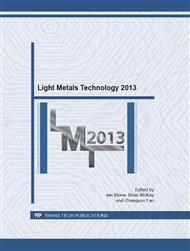p.3
p.8
p.13
p.18
p.23
p.28
p.33
p.38
Compositional Effects on the Restoration Behaviour in Mg-Zn-RE Alloys
Abstract:
Additions of rare earth elements to magnesium alloys are qualitatively reported in the literature to retard recrystallisation. However, their effect in the presence of other (non-rare earth) alloy additions has not been systematically shown nor has the effect been quantified. The microstructural restoration following the hot deformation of Mg-xZn-yRE (x = 2.5 and 5 wt.%, y = 0 and 1 wt.%, and RE = Gd and Y) alloys has been studied using double hit compression testing and microscopy. It was found that, in the absence of rare earth additions, increases in zinc level had a negligible influence on the kinetics of restoration and the microstructure developed both during extrusion and throughout double hit testing. Adding rare earth elements to Mg-Zn alloys was found to retard restoration of the microstructure and maintain finer recrystallised grains. However, in the Mg-Zn-RE alloys, increasing the zinc concentration from 2.5 wt.% to 5 wt.% accelerated the restoration process, most likely due to a depletion of rare earth elements from solid solution and modification of the particles present in the matrix.
Info:
Periodical:
Pages:
18-22
Citation:
Online since:
July 2013
Authors:
Keywords:
Price:
Сopyright:
© 2013 Trans Tech Publications Ltd. All Rights Reserved
Share:
Citation:


